Your guide to the best 15 spots of Asakusa and Ryogoku, a place to feel the history and tradition of Tokyo
13-019-01_4_150811_%E9%9B%B7%E9%96%80_S.jpg)
Asakusa/Ryogoku Area Guide
Asakusa and the surrounding areas are a popular tourist destination in Tokyo showcasing the traditional charm of the city. An old-style cityscape and atmosphere popular with Japanese as well as tourists from abroad can be found here. The Asakusa area has many venues where you can get a taste of old Edo (the original name of Tokyo) and connect with the past, including the Kaminarimon gates at Asakusa Temple. This is one of Tokyo`s most impressive and historic sites and gives you a chance to learn more about the spiritual and traditional side of Japan while exploring the bright lights of Tokyo. There are also ”new fashionable spots” such the Tokyo Sky Tree, Soramachi and other shopping places. Get a feel for the past and envision the future of Japan. Ryogoku is famous for it`s connection to sumo wrestling. There are many sumo stables where they train in the early morning hours. The main National Sumo Stadium is also located here. Here you can find many restaurants specializing in the sumo wrestler`s preferred food, Chankonabe. Close by is the Edo-Tokyo Museum giving you a wonderful introduction to the history of the city inside one of Tokyo`s most impressive buildings. In 2016, "Edo Ryogoku NOREN" entertainment center newly opened, and is an exciting place to visit. The Asakusa and Ryogkoku areas are a place to experience and explore the traditions and history of Tokyo.
13-019-02_%E6%9C%AC%E5%A0%82.jpg)
A Sensoji Temple
13-019-01_4_150811_%E9%9B%B7%E9%96%80_S.jpg)
B Kaminarimon Gate / Nakamise Shopping Street
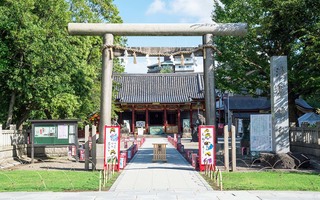
C Asakusa Shrine
13-019-04%E6%B5%85%E8%8D%89%E8%8A%B1%E3%82%84%E3%81%97%E3%81%8D3.jpg)
D Asakusa Hanayashiki
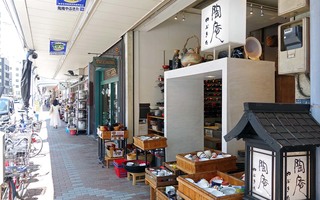
E Kappabashi Dougu Street
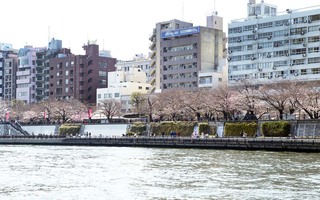
F Sumida Park
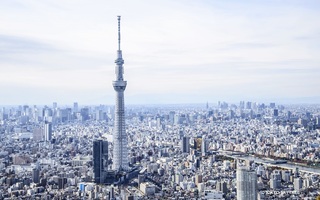
G Tokyo Skytree
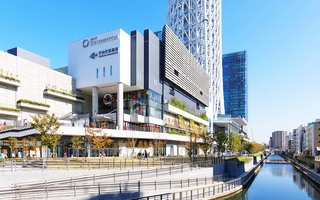
H Tokyo Sora Machi
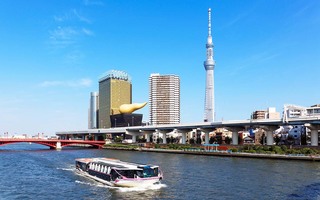
I Sumida River
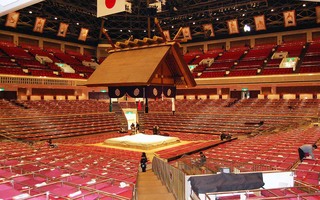
J Kokugikan
13-019-15%E6%97%A7%E5%AE%89%E7%94%B0%E5%BA%AD%E5%9C%92.jpg)
K Former Yasuda Garden
A
Sensoji Temple
13-019-02_%E6%9C%AC%E5%A0%82.jpg)
Sensoji Temple has a history of over 1400 years and is considered one of the oldest in Tokyo. The temple is a place of worship due to the enshrinement of the Asakusa Kannon. Every year over 30 million people from Japan and abroad visit the temple to pray and see the historical site. Sensoji Temple is famous for the enormous red Kaminari Lantern (Kaminarimon) hanging from the main gates and the fun and interesting shopping arcade (Nakamise street) which leads to the main temple. Sensoji's main building houses a statue that was discovered by fishermen in 648 in the Sumida River. Another impressive structure is the 53 meter five storied pagoda in the central courtyard.
B
Kaminarimon Gate / Nakamise Shopping Street
13-019-01_4_150811_%E9%9B%B7%E9%96%80_S.jpg)
Kaminarimon is one of two large gates guarding the entrance to Sensoji Temple at the center of the Asakusa Temple complex. The large hanging chochin, paper lantern, is a symbol of the area and easily recognized by all Japanese. On both sides of the gate are two guardian gods, Fujin is the god of wind and Raijin is the god of thunder. The correct name for this gate is the “Furaijinmon” because of the gods standing on both sides of the entrance. From the front gate to the main temple structure is a long 250m path with wonderful and eclectic shops lining the sides. This enjoyable shopping area is called the Nakamise Street and is considered one of the oldest shopping arcades in all of Japan. Most of these shops have a long history with some even dating back hundreds of years. Wander the side streets in search of gourmet shops very popular with foodies. Visiting the area at night when most of the visitors have gone is also a fun experience to see the temple lit up and feel the history of the area.
C
Asakusa Shrine

The Sanja Matsuri is one of Tokyo's most famous and entertaining festivals and is held by the shrine located right next to Sensoji Temple. The shrine is a registered important cultural property by the national government of Japan. Until the Edo period the shrine and temple were housed in the same building, but during the Meiji Restoration, Shinto was made the official religion of Japan and the places of worship were separated. The popularity of the shrine since old times can be attributed to three main historical figures. The celebration of these three are the basis for the Sanja Matsuri. The third Tokugawa shogun is enshrined at the Toshogu Shrine in Nikko, Tochigi, prefecture. Many people found it difficult to travel that distance to pray so Asakusa Shrine was designated as an alternative for those devoted patrons. The main hall of worship and the part of the shrine used to house offerings are connected by a corridor. Many people connected with the art of dance and performance come here to worship and pray to the enshrined spirits for help with their art. You can also see the mikoshi, portable shrines, used in the famous Sanja Matsuri.
D
Asakusa Hanayashiki
13-019-04%E6%B5%85%E8%8D%89%E8%8A%B1%E3%82%84%E3%81%97%E3%81%8D3.jpg)
The Asakusa Hanayashiki is a classic amusement area located in the heart of Tokyo. The rides appeal to young children and there are many things to enjoy here. Quality family time can be shared on one of the many attractions in the park. There is a ferris wheel, a coffee cup ride, a small roller coaster, the popular Skyride, and much more. The park has a history dating back to 1870 and was originally opened as a flower park, but has since started to include many more interesting attractions. The cute amusement park is located just a few blocks from Sensoji Temple and is a great balance to a day of temples and shrines, especially if you have children with you.
E
Kappabashi Dougu Street

The Kappabashi Dougu Street began with the opening of several trading stores specializing in tools and wares around the Taisho Era. There are now about 170 shops in the area, making it the most impressive concentration of culinary tool shops in all of Japan. Kappabashi Dougu Street is nearly 800 m long and walking the area you can see a wonderful variety of items essential to the culinary arts. From cooking utensils, dishes and kitchen equipment, to lacquerware, food samples, chef's clothing, and more can be found along the stretch between Asakusa and Ueno. In addition to tourists, the area is popular with professional chefs who come to purchase tools for their trade, and shops dealing with kitchen utensils used by ordinary families have increased. The green mythological river dwelling creature ”Kappa Kawatarō" is the area's mascot, and a statue was built in commemoration of the area`s 90th anniversary in 2003.
F
Sumida Park

Sumida Park is a large green park with an area of about 80,000 square meters and a wonderful walking path along the Sumida River. Approximately 700 cherry blossom trees run along both sides of the river for a 1km stretch, attracting many people for the popular Japanese activity, Hanami, cherry blossom viewing. The rows of cherry blossom trees are said to have been planted during the reign of the 8th Tokugawa Shogun. This spot has been selected as one of the best “100 Sakura Cherry Blossom Areas” in Japan. Summer is also a popular time for Sumida Park's riverside for the reknowned Sumida Fireworks. There are also various events held throughout the year, such as the Plum Festival, Yabusame Horse Back Archery, Hydrangea Walk, Paper Lantern Floating and more.
G
Tokyo Skytree

The Tokyo Skytree was completed in 2012 and is the world`s tallest free standing structure at 634 meters. Saying the number 634 in Japanese is phonetically similar to the traditional name of the area in which it is built, Musashi. Musashi is a name associated with many famous figures in Japanese history. It is a number that connects it with the local area and also makes it easy to remember for people across Japan. There are two observation decks that you can visit, one at 350 meters and another at 450 meters from which you can enjoy the beautiful panoramic views of Tokyo and the old Musashi Province. The tower has become a popular tourist destination, but serves a very important purpose. The Skytree provides digital signals for the population of Tokyo, as buildings and skyscrapers began to make the Tokyo Tower signal height ineffectual. There are also office buildings, shops, and shopping areas to enjoy at the base of the tower at “Tokyo Skytree Town.” Make sure to check it out in the evening too when the Skytree is lit up in beautiful colors.
H
Tokyo Sora Machi

Sora Machi can loosely be translated as “Skytown” and is the shopping and entertainment complex at the base of Tokyo Skytree. A concept of creating a shopping experience that combines new themes with Tokyo`s merchant past as a famous castle town. There are over 300 restaurants, shops, and other entertainment venues to explore. There is also an aquarium and planetarium on site. The Sumida Aquarium on the 5th floor showcases the beauty and diversity of the sea life found around Tokyo's Ogasawara islands that jut far out into the Pacific Ocean. The islands are considered the “Galapagos of the Western Pacific” and are a main theme of the aquarium, “The Sea of the Tokyo Islands.” You can also see many penguins and fur seals swimming in one of Japan`s largest indoor open pools. On the 7th floor is the “Konica Minolta Planetarium” that features light and music shows in addition to showcasing a star-filled sky.
I
Sumida River

The Sumida river is about 23.5 km in length and flows past roughly 3 million people living in the greater Tokyo area. Considered one of the great rivers of the world, it flows through the city center and connects to Tokyo Bay. The upper stream is the Arakawa river, and becomes the Sumida river from the branch point called Iwabuchi flood gates near Akabane. On both sides of the Sumidagawa river there is a promenade called "Sumidagawa Terrace" and a wide green area many people use as a place for relaxation and sports. In the spring, nearly 1,000 cherry blossoms bloom on both sides where many people visit for hanami, or cherry blossom viewing. There are also a number of events held during the year, such as a large fireworks display called the ”Sumidagawa Fireworks Festival" in summer. The fireworks event is so impressive and popular that it is even aired on TV. There is a water bus "Tokyo Cruise" that runs along the river making connections to many popular places like Asakusa, Hamarikyu Gardens · Hinodesanbashi · Odaiba Beach Park and Toyosu. There are other stops the water bus makes and you can easily access and enjoy the shopping and entertainment area Palette Town or the event venue Tokyo Big Site in Odaiba.
J
Kokugikan

Ryogoku is the name of the area most closely associated with sumo in Japan. The area is home to the national sumo stadium, many sumo training stables, restaurants featuring Chankonabe, and many other attractions. Ryogoku means “Two Countries” and is derived from the construction of a bridge that spanned the wide flowing Sumida River in 1659 connecting “two countries.” The main sumo stadium is called Ryogoku Kokugikan and hosts popular sumo tournaments in January, May, and September of every year. The sumo tournament is held three times a year with other tournaments held in Nagoya, Osaka, and Fukuoka. There are different seating options you can choose from to view a sumo bout. Areas designated for groups of four, seating on the floor close to the main ring, or seating in the upper decks of the arena. Simultaneous translation and commentary of the sumo bouts are available in English through rentable audio devices. It is a great way to enjoy the sumo bouts and enrich your experience and knowledge. In the same building is a museum and gift shop where you can get sumo related goods, but during sumo bouts this area is only accessible to ticket holders. The museum is a chance to learn more about this traditional sport with a long and sacred history in Japan. The venue is also sometimes used for boxing and pro-wrestling events. Ryogoku will be the venue used for boxing during the 2020 Tokyo Summer Olympics.
K
Former Yasuda Garden
13-019-15%E6%97%A7%E5%AE%89%E7%94%B0%E5%BA%AD%E5%9C%92.jpg)
The Former Yasuda Garden was made in the Edo period and is a large strolling garden built around a central pond. This is one of the most famous gardens dating back to the Edo period and draws water from the Sumida River. The gardens are located close to the National Sumo Arena from which you can enjoy wonderful views of the towering Tokyo Skytree. The pond is in the shape of the Japanese kanji, Kokoro, which means “heart.” The pond hosts a number of creatures, including colorful carp, sun bathing turtles and waterfowl also visit the area. On the garden grounds is a beautiful red bridge crossing the pond and a shrine dedicated to the inari gods of fortune. This is a recommended spot to escape some of the bustle of Tokyo and find a quiet place to connect with the nature, culture, and peace of Tokyo.